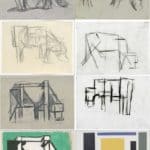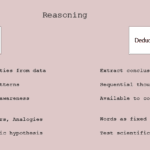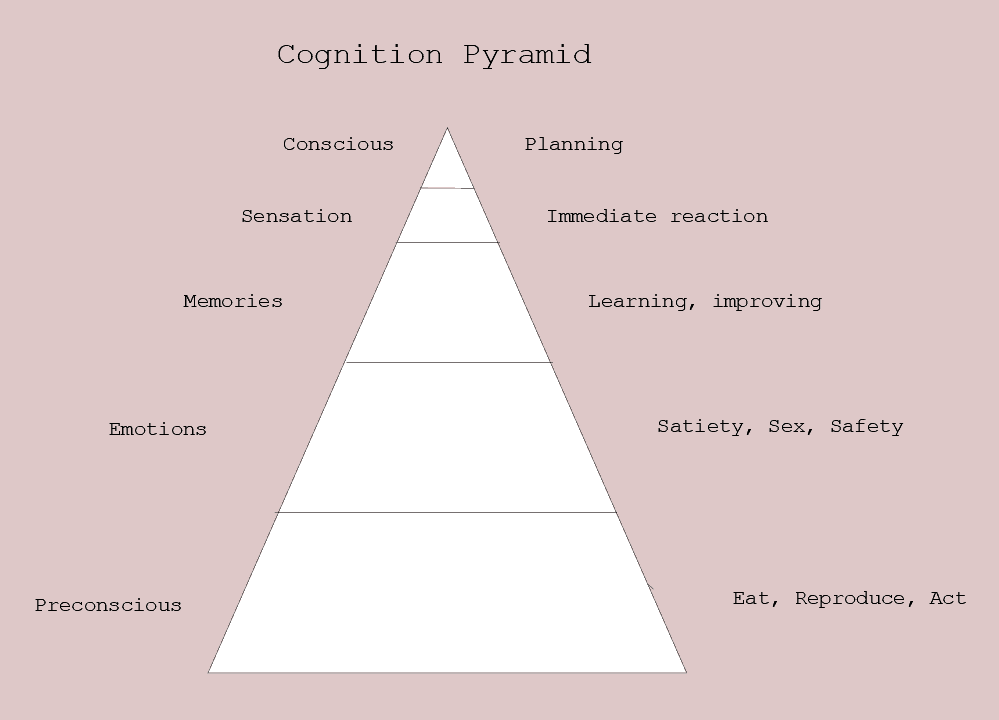Cognition is the sum total of all mental processes in the brain. The cognition pyramid, Figure 15.1, is a diagram of the psychology of reasoning that Mental Construction uses. The mental processes parallel brain structures which support the process.
- Preconscious behaviors arise in the brainstem, with bodily movements controlled by the cerebellum
- Emotions, momentary responses to environmental situations, arise in the amygdala of the limbic system
- Memories encoded by the limbic’s hippocampus into the cortex, supports learning, enhancing responses to challenges and opportunities
- Sensory processing in the cortex enhances identification of objects in environment, near and far
- Planning for the future requires the enlarged prefrontal cortex of homo sapiens
Cognition
- Cognition, the process involved in knowing, or the act of knowing. According to this definition, cognition cannot occur until memory is available. It is more restrictive, excluding most pre-conscious thought.
- Cognition includes all conscious processes by which knowledge is accumulated, such as perceiving, recognizing, conceiving, and reasoning.
- Put differently, cognition is a separate mental process that can be distinguished from a feeling.
Thought
Let’s also distinguish between thought and reasoning. Referring to the Encyclopedia Britannica and to Merriam-Webster Dictionary, a useful partition is exposed.
- Thought is the highest level of cognition. It consists of internal symbolic representations of the internal worldview (mindset) and the current environment stimuli.The internal representation can be 1) word-based or 2) pattern-based or some of both. If external stimuli do not require immediate reaction, other inputs are be provided by personal needs, goals, or fears.
- There are uses of the word thinking or thought that are not used here. For instance, in casual conversation, the word thinking covers other distinct psychological activities—tending to believe or degree of attentiveness, e g., “I did it without thinking” or whatever is in consciousness, “It made me think of my grandmother.”
- Thought, or thinking, is considered here in its role of mediating between inner activity and external stimuli. We think to develop responses to our reality. These responses range from conversational gambits to physical behaviors.
- In Mental Construction, one focus is thinking as an intellectual exertion, aimed at finding an answer to a question or solving a problem.
Reasoning
Merriam-Webster defines reasoning–the action of thinking about something in a logical, sensible way. The key word, logical, has two main uses. First, according to the rules of logic or formal argument and second, characterized by or capable of clear, sound reasoning.
Unfortunately, the emphasis on logic obscures the essential role of induction in generating the premises on which the logical argument is made. The premises are the facts or presumed facts with various assurance we start our reasoning with. Those facts arise from data clustering of novel situations, recognition of already learned classifications, and the fortunes of our experience. Each of these underlying methods are built by the neural process of the Almost Gate. Abstraction, shedding of superfluous data, occurs automatically at each Almost Gate in the cortex. This abstraction necessarily leads to categorization, which supports the ready association of similar categories.
In the investigation about what we reason about, we must consider what comes to our conscious attention. The associations a current event causes can affect what our premises in a logical argument are as much as the event itself.
Sources of Thought

The 3S Imperatives which arose before our species do not vanish, but rise up through layers, often to our conscious mind as sources of our thoughts.
Concept Elevator

Successive abstraction marches our perceptions up a concept elevator.
Neural Cascade

The neural cascade describes the cumulative loss of fidelity across the Almost Gates.
Reasoning

Reasoning is accomplished with both deductive logic and by induction with similarity.
Links to Other Cognition Aspects
Parallel Thought Paths Want a discussion of two thoughts competing
Left-Right Brain Distinct modes working together
Triune and Dual Process Three brains and fast-and-slow altogether now
